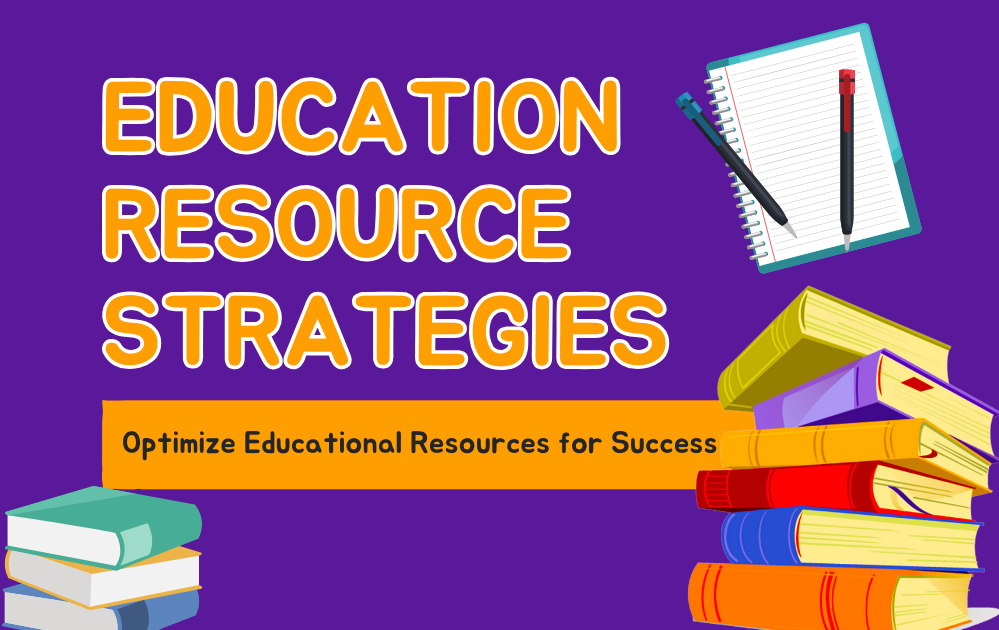Education Resource Strategies
Optimize Educational Resources for Success
Introduction
Education Resource Strategies : Have you ever felt like no matter how many educational tools or materials you have at your disposal, the learning outcomes don’t match the effort? You’re not alone. Teachers and parents alike often grapple with the overwhelming task of managing resources to achieve the best results for learners. But here’s the good news: with the right strategies, you can transform how you use educational resources, maximizing their potential and creating impactful learning experiences.
This guide will walk you through proven strategies to optimize educational resources, offering actionable tips and tools tailored for both teachers and parents. By the end of this article, you’ll have a clear roadmap to ensure every resource in your toolkit works harder and smarter for student success.
What Are Education Resource Strategies?
At their core, education resource strategies are methods and practices designed to make the best use of available learning tools, whether physical, digital, or human. These strategies ensure that resources are not just plentiful but effective in meeting the diverse needs of learners.
Examples of Educational Resources:
- Physical Materials: Textbooks, manipulatives, science kits, classroom furniture.
- Digital Tools: Educational apps, eBooks, learning management systems.
- Human Resources: Teacher collaboration, parental involvement, peer learning.
By understanding what’s available and aligning it with learning goals, you can create an optimized environment where every resource plays its part.
Why Optimizing Educational Resources Is Crucial for Success
Optimizing resources isn’t just a nice-to-have; it’s essential for fostering meaningful learning experiences. Here’s why:
Impact on Student Outcomes
Studies show that well-allocated resources lead to higher engagement, better test scores, and improved overall performance. For instance, classrooms with thoughtfully integrated technology see a 20% increase in student participation.
Challenges in Resource Utilization
- Inefficient Use: Resources often go unused due to poor organization or lack of training.
- Accessibility Issues: Many schools and homes lack equitable access to essential tools.
- Cost Constraints: Tight budgets can limit the availability of high-quality resources.
Benefits of Optimization
- Improved Engagement: Students are more likely to participate when tools are relevant and engaging.
- Cost-Effectiveness: Stretch limited budgets further by maximizing resource impact.
- Time Efficiency: Spend less time searching and more time teaching or learning.
Practical Education Resource Strategies for Teachers
Organizing Classroom Resources for Maximum Impact
Creating an organized classroom is the foundation of resource optimization. When everything has its place, you save time and reduce distractions.
Actionable Tips:
- Divide your classroom into zones: reading corners, STEM areas, and creative spaces.
- Use color-coded bins or labels to make resources easy to find.
- Maintain an inventory of frequently used materials and replenish as needed.
Leveraging Technology for Smarter Resource Management
Technology can revolutionize how you manage and deploy resources. By integrating digital tools, you can simplify lesson planning and improve student engagement.
Recommended Tools:
| Tool | Purpose | Benefits |
|---|---|---|
| Google Classroom | Assignments and collaboration | Streamlined communication |
| Kahoot! | Interactive quizzes | Fun and engaging |
| Canva for Education | Creative projects | Easy-to-use design tools |
These tools don’t just make your job easier; they help students connect with the material in dynamic ways.
How Parents Can Optimize Educational Resources at Home
Creating a Learning-Conducive Environment
Your home setup plays a significant role in how well your child learns. A designated space can help foster focus and creativity.
Steps to Create an Effective Study Space:
- Choose a quiet, clutter-free area with good lighting.
- Stock it with versatile resources like whiteboards, notebooks, and markers.
- Limit distractions by keeping the area device-free during study time.
Incorporating Free or Affordable Educational Tools
You don’t need to break the bank to provide quality learning resources. Plenty of free or low-cost tools can deliver exceptional value.
| Resource Type | Free Options | Premium Options |
| Reading Platforms | Epic! | Raz-Kids |
| Math Practice Tools | Khan Academy | IXL |
| Science Experiments | DIY.org | KiwiCo Kits |
Collaborative Strategies to Maximize Impact
Building Teacher-Parent Partnerships
Collaboration between teachers and parents ensures that resources are aligned and utilized effectively both at school and home.
Tips for Stronger Partnerships:
- Establish open communication through regular updates and meetings.
- Use shared tools like Google Calendars or Seesaw to track progress.
- Align on goals and strategies for resource use.
Encouraging Peer-Led Learning
Peer learning is an excellent way to optimize human resources while building collaboration skills.
How to Facilitate Peer Learning:
- Encourage group projects where students share materials.
- Rotate classroom resources across grade levels to maximize usage.
Measuring the Success of Education Resource Strategies
It’s essential to evaluate the effectiveness of your strategies to ensure continuous improvement.
Key Metrics to Track:
- Student Outcomes: Monitor grades, test scores, and participation.
- Resource Usage: Assess how often and effectively materials are used.
- Feedback: Collect input from students, parents, and teachers.
Use tools like surveys or classroom observation checklists to gather insights and adjust strategies accordingly.
FAQs About Education Resource Strategies
What Are Educational Resources in Simple Terms?
Educational resources are tools or materials—physical, digital, or human—used to support teaching and learning.
How Can Teachers Save Money on Resources?
You can save by applying for grants, utilizing free online tools, and participating in community resource-sharing programs.
What Are the Best Strategies for Students with Special Needs?
Adaptive technologies, sensory-friendly tools, and individualized learning plans are excellent strategies to ensure inclusivity.
How Do I Know If My Resource Strategy Is Working?
Track measurable outcomes like improved engagement and performance. Regular feedback from students and parents also helps gauge success.
Conclusion
Optimizing educational resources is a game-changer for fostering meaningful learning experiences. Whether you’re a teacher streamlining classroom tools or a parent creating a focused study environment at home, the strategies outlined here will help you make the most of what you have.







